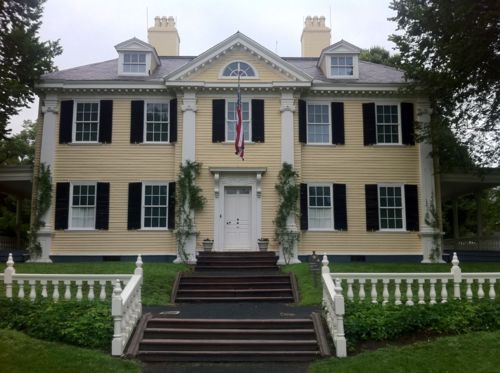
At the home of Henry Wadsworth Longfellow on Brattle Street in Cambridge, Mass., I stopped this gray, muggy morning to take a photo near the end of my bike ride. I had McLuhan on my mind, wondering what I might find today in his chapter on The Photograph in Understanding Media.
Sure enough, at page 194 I found a reference to poets.
Perhaps the greatest revolution produced by photograph was in the traditional arts. The painter could no longer depict a world that had been much photographed. He turned, instead, to reveal the inner process of creativity in expressionism and in abstract art. Likewise, the novelist could no longer describe objects or happenings for readers who already knew what was happening by photo, press, film, and radio. The poet and novelist turned to those inward gestures of the mind by which we achieve insight and by which we make ourselves and our world. Thus art moved from outer matching to inner making.
Longfellow was born in 1807, and the first permanent photograph was created in 1826. Photography became a viable medium by 1839, when he was 22 years old. So maybe his poetry moved toward “inward gestures of the mind” because of the new technology? I find that quite a stretch. The following concluding stanza of “A Psalm of Life” , a memorized favorite of my father’s, was first published in 1838, offering unforgettable insight of the sort by which we make ourselves and our world, well before the ubiquity of photography:
Let us then be up and doing,
With a heart for any fate;
Still achieving, still pursuing,
Learn to labor and to wait.
And what of William Wordsworth? He began writing his greatest work, The Prelude, a quarter-century before the first photograph. Talk about inward gestures of the mind! Here’s a sample from Book 1:
Dust as we are, the immortal spirit grows
Like harmony in music; there is a dark
Inscrutable workmanship that reconciles
Discordant elements, makes them cling together
In one society. How strange that all
The terrors, pains, and early miseries,
Regrets, vexations, lassitudes interfused
Within my mind, should e’er have borne a part,
And that a needful part, in making up
The calm existence that is mine when I
Am worthy of myself! Praise to the end!
So once again I find sport in testing McLuhan’s cosmic generalities with individual data points. So what? McLuhan himself followed the inward gestures of his mind as a writer of poetic sensibility. It doesn’t take much snipping and arranging to make a sort of poem from this very chapter. Like this:
Thus art moved from outer matching
to inner making.
The photograph is not a machine,
but a chemical and light process that,
crossed with the machine,
yields the movie.Yet there is a vigor and violence
in these hybrid forms
that is self-liquidating,
as it were.
There you have it. I’m sure Mr. McLuhan and Mr. Longfellow would have had a lot to talk about in one of the grand sitting rooms at the Brattle Street manse. Fun to imagine.
 Send to Kindle
Send to Kindle
I was searching for more insight into this very chapter of Understanding Media when I came across your blog. I’m curious if you still feel the same after finishing the chapter. I thought McLuhan made it very clear near the end of the chapter that exploring the “inward gestures of the mind” long predated the technology of photography.
On page 201 he writes “More than a century of this pictorial analysis of the inner life preceded Talbot’s 1839 discovery of photography…Poets and painters invaded this inner landscape world long before Freud and Jung brought their cameras and notebooks to capture states of mind”.
I don’t think his previous statements were necessarily cosmic generalities nor was he contradicting himself. I think he explains both statements when he says “The photograph might be said, to have brought to human attention the subvisual world of bacteria that caused Louis Pasteur to be driven from the medical profession by his indignant colleagues”. I think what was meant is that photography is a tool to help more people have deeper insight and better express what poets and painters seem to have known long before.